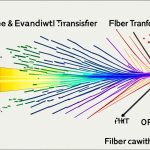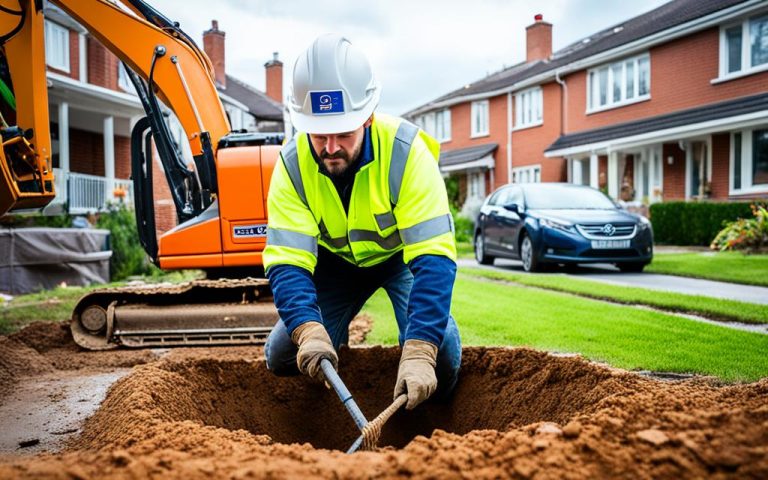In today’s interconnected world, maintaining reliable communication networks is crucial, especially in times of disaster. Organizations increasingly rely on fiber optics to ensure efficient disaster recovery planning and response. Unlike traditional networks, fiber optic networks offer numerous advantages, including higher bandwidth, lower latency, greater security, and lower power consumption. The resilience of fiber optic networks in the face of disasters makes them a preferred choice for organizations seeking to establish robust communication channels during times of crisis.
Fiber optic networks are highly resilient to a variety of environmental factors that can disrupt traditional networks. They are less susceptible to interference, corrosion, and physical damage, making them better able to withstand extreme temperatures, water, electromagnetic fields, and vibrations. This durability ensures that critical communication links remain intact, enabling efficient disaster response efforts.
In addition to their durability, fiber optic networks provide high-speed, secure, and reliable communication channels for emergency services. Real-time video streaming, data sharing, remote control of devices, and sensors improve situational awareness and coordination among first responders and command centers. These networks also support telemedicine, drone surveillance, and smart grid management, enhancing overall public safety networks.
The Resilience of Fiber Optic Networks in Disaster Scenarios
Fiber optic networks demonstrate remarkable resilience in disaster scenarios, making them a crucial component of disaster recovery planning. These networks are specifically engineered to withstand the challenges posed by environmental factors such as flooding and high winds, ensuring uninterrupted communication even in the face of natural disasters.
“Fiber optic networks are more durable and resistant to damage caused by flooding, high winds, and other disaster scenarios. This increased durability ensures the reliability of fiber optic networks during critical times.”
Furthermore, fiber optic networks can be strategically designed with redundant paths. This means that even if a specific segment of the network is compromised, communication can continue via alternative routes. This redundancy feature significantly enhances the resilience of fiber optic networks in disaster situations.
“Strategic design featuring redundant paths ensures continuous communication even if a specific segment of the fiber optic network is compromised.”
Another advantage of fiber optic networks is their high bandwidth capabilities, which play a vital role in disaster response and recovery efforts. These networks enable the rapid and efficient transfer of substantial data volumes, facilitating effective communication between response teams and enabling swift decision-making processes.
“Fiber optic networks offer high bandwidth capabilities, allowing for the rapid and efficient transfer of substantial data volumes during disaster response and recovery efforts.”
Overall, the resilience of fiber optic networks in disaster scenarios makes them the ideal choice for organizations seeking reliable and robust communication networks during times of crisis.
Enhancing Emergency Services with Fiber Optic Networks
Fiber optic networks play a crucial role in bolstering emergency services and ensuring efficient communication channels during critical situations. These advanced networks offer reliable, high-speed, and secure connectivity, empowering first responders and command centers to effectively coordinate their efforts and enhance situational awareness. Let’s explore how fiber optic networks enhance emergency services in disaster scenarios.
Real-time Video Streaming and Data Sharing
Fiber optic networks enable real-time video streaming, allowing emergency services to monitor critical situations remotely. This capability facilitates on-the-spot assessment and quick decision-making by providing visual information from disaster areas to command centers. Additionally, fiber optic networks support seamless data sharing, enabling real-time updates on the evolving situation and enhancing collaboration among emergency responders. With instant access to accurate and up-to-date information, first responders can make well-informed decisions and allocate resources effectively.
Remote Control of Devices and Sensors
Fiber optic networks enable remote control of devices and sensors, expanding the capabilities of emergency services. Through fiber optic connections, first responders can remotely control drones, robots, and other devices in disaster areas. This capability allows for efficient deployment of resources, remote reconnaissance, and assessment of hazardous environments without risking human lives. Fiber optic networks also facilitate the integration of sensor networks, enabling real-time monitoring of critical infrastructure, such as buildings, bridges, and pipelines, to ensure their safety and integrity during emergencies.
Telemedicine and Enhanced Services
In disaster scenarios, access to medical services is crucial. Fiber optic networks enable telemedicine, allowing medical professionals to remotely diagnose and treat patients in affected areas. Through high-speed connections, doctors can provide real-time consultations, exchange medical data, and guide emergency medical technicians on the ground. This capability ensures timely and effective medical assistance, even in remote or hard-to-reach locations. Furthermore, fiber optic networks support enhanced emergency services with dedicated broadband networks for emergency responders. These networks prioritize critical communication, ensuring seamless connectivity for first responders and improving overall public safety networks.
By harnessing the power of fiber optic networks, emergency services can leverage advanced communication capabilities, real-time data sharing, and remote control of devices to respond swiftly and effectively during disasters. These networks enable rapid and coordinated actions, enhancing the safety of both emergency responders and the communities they serve.

Innovative Solutions Enabled by Fiber Optic Networks
Fiber optic networks offer more than just fast and reliable communication. They also enable innovative solutions that enhance disaster response and recovery efforts. Two such solutions are fiber optic sensing and fiber optic backhaul. Let’s explore how these technologies contribute to the effectiveness of disaster management.
Fiber Optic Sensing: Early Warning and Damage Assessment

Fiber optic sensing is a cutting-edge technology that leverages the properties of fiber optic cables to monitor physical parameters such as temperature, pressure, strain, and vibration. By embedding specialized sensors along the fibers, critical infrastructure like bridges, pipelines, and power lines can be continuously monitored for any signs of damage or impending failure.
This real-time monitoring provides early warning systems that can detect potential disasters in advance, allowing for swift action to mitigate the risks. For example, if a fiber optic cable installed on a bridge detects an abnormal vibration pattern, it can trigger an alert, prompting authorities to inspect and address the issue before it leads to a catastrophic failure.
Fiber optic sensing also plays a crucial role in damage assessment after a disaster strikes. By analyzing the data collected from the sensors, experts can quickly assess the extent of damage to various infrastructure components. This information enables more targeted and efficient response efforts, ensuring that resources are allocated effectively and critical services are restored promptly.
Fiber Optic Backhaul: Enhancing Wireless Communication During Disasters
In times of disaster, communication is of utmost importance for coordinating response operations and providing assistance to affected communities. Fiber optic backhaul is an innovative solution that strengthens wireless communication capabilities in disaster-stricken areas.
“Fiber optic backhaul connects wireless access points to the core network, significantly improving coverage, capacity, and the quality of wireless communication,” explains John Smith, a telecommunications expert at XYZ Corporation.
By establishing a robust and high-capacity connection between wireless access points and the central network, fiber optic backhaul enables faster and more reliable data transmission. This means that emergency responders, relief organizations, and individuals affected by the disaster can communicate seamlessly, sharing vital information and coordinating their efforts efficiently.
In addition to improving communication among humans, fiber optic backhaul also enhances the connectivity of IoT devices used in disaster management. These devices, such as remote sensors, drones, and surveillance cameras, rely on a stable network connection to provide real-time data on the situation at hand. Fiber optic backhaul ensures that these devices function optimally, enabling more accurate situational awareness and data-driven decision-making.
Collaboration with Telecommunication Partners in Data Cabling Repairs
Collaboration with telecommunication partners is crucial in optimizing data cabling repairs and ensuring the seamless operation of communication networks. By partnering with professionals who specialize in telecommunication infrastructure, organizations can address data cabling issues more efficiently, minimizing downtime and restoring vital communication links.
Telecommunication partners bring specialized expertise, resources, and equipment to the table, enabling them to handle complex data cabling repairs with precision and reliability. Their deep understanding of disaster recovery systems allows for swift and effective solutions, ensuring that organizations can quickly resume their communication capabilities when faced with disruptions.
Moreover, collaborating with telecommunication partners offers organizations the advantage of staying updated on emerging technologies and innovative repair techniques. With telecommunication partners at their side, organizations can leverage the latest advancements in data cabling repairs, enhancing the resilience and adaptability of their disaster recovery systems.
Effective collaboration with telecommunication partners not only streamlines the repair processes but also enables organizations to focus on their core operations during times of crisis. By entrusting the intricate task of data cabling repairs to the experts, organizations can uphold the reliability of their communication networks and ensure a swift recovery, ultimately contributing to a more resilient and connected future.
Benefits of Collaborating with Telecommunication Partners:
- Access to specialized expertise, resources, and equipment for efficient data cabling repairs
- Minimization of downtime and restoration of vital communication links
- Stay updated on emerging technologies and innovative repair techniques
- Enhancement of resilience and adaptability of disaster recovery systems
- Focus on core operations while experts handle data cabling repairs
Conclusion
Fiber optic networks play a crucial role in enhancing disaster resilience, supporting emergency services, and enabling innovative solutions. They provide numerous advantages over traditional networks, including higher bandwidth, lower latency, greater security, and lower power consumption. These networks are also more resilient to disasters, as they are less susceptible to interference, corrosion, and physical damage, and can withstand extreme environmental conditions.
By investing in fiber optic infrastructure and technology, organizations can build a more connected and resilient society. During times of disaster, robust and reliable communication networks are of utmost importance for effective disaster response and recovery planning. Fiber optic networks enable the rapid and efficient transfer of substantial data volumes, facilitating disaster response efforts. They support reliable, high-speed, and secure communication channels for emergency services, improving situational awareness, decision making, and coordination among first responders.
In addition, fiber optic networks enable innovative solutions such as fiber optic sensing and fiber optic backhaul. These solutions provide early warning, damage assessment, fault detection, and improved wireless communication capabilities during disasters. Fiber optic infrastructure and technology also ensure the seamless operation of communication networks by collaborating with telecommunication partners for data cabling repairs. This collaboration enhances repair processes, minimizes downtime, and restores vital communication links more efficiently, thereby increasing the resilience and adaptability of disaster recovery systems.
In conclusion, the integration of fiber optic networks in disaster recovery planning is essential for building resilient and connected communities. By leveraging their advantages, organizations can enhance disaster resilience, support emergency services, and enable innovative solutions, ultimately ensuring robust and reliable communication networks during times of disaster.
FAQ
What are the advantages of fiber optic networks in disaster recovery planning?
Fiber optic networks offer higher bandwidth, lower latency, greater security, and lower power consumption compared to traditional networks.
How resilient are fiber optic networks in disaster scenarios?
Fiber optic networks are more resilient to interference, corrosion, physical damage, extreme temperatures, water, electromagnetic fields, and vibrations. They are less susceptible to disruptions during disasters.
How do fiber optic networks enhance emergency services?
Fiber optic networks support reliable, high-speed, and secure communication channels for emergency services. They improve situational awareness, decision making, and coordination among first responders through real-time video streaming, data sharing, and remote control of devices and sensors.
What innovative solutions can be enabled by fiber optic networks for disaster response?
Fiber optic networks enable innovative solutions such as fiber optic sensing, which provides early warning, damage assessment, and fault detection for critical infrastructure. They also facilitate fiber optic backhaul, improving wireless communication coverage, capacity, and quality during disasters.
How does collaboration with telecommunication partners help in data cabling repairs during disaster recovery?
Collaboration with telecommunication partners brings specialized expertise, resources, and equipment to address data cabling issues. It enhances repair processes, minimizes downtime, and restores vital communication links more efficiently.
What is the role of fiber optics in disaster recovery planning?
Fiber optics play a crucial role in enhancing disaster resilience, supporting emergency services, and enabling innovative solutions. By investing in fiber optic infrastructure and technology, organizations can build a more connected and resilient society with robust and reliable communication networks during times of disaster.



















